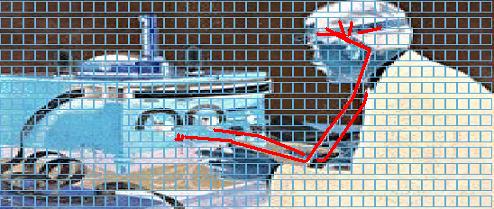BY LETTER
Thought-Stream Recorder
Technology > Application > Augmentics
Technology > Application > Communications
Technology > Technology Type or Material > Virtual/Infotech
Technology > Application > Communications
Technology > Technology Type or Material > Virtual/Infotech
 Image from Steve Bowers |
A cybernetic device that continually records a sophont's thoughts into a log that can be inspected later. Typically used in conjunction with DNI, it is employed for forensic, introspective, research, and security purposes.
History
Thought-stream recorders are an old and mature technology, dating back to the emergence of first commercial DNI systems during the Information Age on Old Earth. The precursor devices were little more than glorified notepads, allowing users to record specific thoughts through their DNI if they were in circumstances where stopping to record their thoughts in a more formal format would be inconvenient or impossible. These primitive devices were incapable of recording thoughts in their raw form, instead forcing users to think in some structured language before their thoughts could be understood. Despite severe limitations, these devices became valuable tools to researchers in a variety of fields, who could now have test subjects record their daily choices and activities with a minimum of hassle. Since a significant amount of baseline thoughts occurs outside of individual's awareness, and since explicit prompting tends to skew results, there was a continual push to refine the scope of such devices until they could record a full range of baseline thoughts without any conscious effort on the part of the user.Though originally a research tool, these 'thought-stream recorders' soon found uses outside of laboratories: self-improvement enthusiasts and certain religious groups jumped at the chance to monitor their thought patterns and identify areas that they need to work on; media corps used it on test audiences to estimate the effectiveness of their entertainment and advertising campaigns; ordinary people often used to augment their memories; and more esoteric groups had their own uses for it -- such as the Dream Adepts, who sought to record and consciously experience their dreams.
Use in Entertainment
As the technology matured and spread among the populace, a class of passive entertainment works began incorporating thought-streams into the experience, allowing viewers not only to see through protagonist's senses, but to experience eir thoughts and feelings as well. Though crude at first, it eventually reached a level where certain works were widely banned for being too addictive or profoundly damaging to baseline psyche. Due to the lack of modern insights about memetics and nonexistence of effective mental security, use of entertainment that contained thought-streams was risky and often exposed users to powerful memetic payloads, leading to a period where they were heavily regulated.In the modern era use of thought-streams in entertainment is widespread and mostly safe, due to long experience with the technology and greater memetic expertise.
Controversies
A number of ethical and legal issues plagued the technology from its inception. Thought-stream recordings were sometimes confiscated by law enforcement agencies as forensic evidence proving malicious intent, and in some polities the devices were mandatory for repeated criminals, or even all citizens. This led to many groups demanding that the technology be banned or restricted as a tool of oppression. At the same time, the records were often stolen by criminals, misused, or used in malicious ways — causing other groups to denounce the technology as a threat to public order.Ultimately, with the development of more powerful technologies (such as AI, uploading, backups, and such), the implications of thought-stream recorders became meager by comparison, and faded out of the spotlight.
Related Articles
Appears in Topics
Development Notes
Text by Domagoj K
Initially published on 20 December 2009.
Initially published on 20 December 2009.






